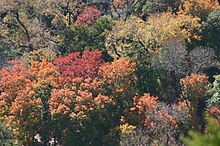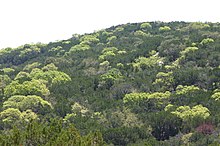This is an old revision of this page, as edited by 210.213.195.139 (talk) at 10:05, 23 September 2008 (→Botany). The present address (URL) is a permanent link to this revision, which may differ significantly from the current revision.
Revision as of 10:05, 23 September 2008 by 210.213.195.139 (talk) (→Botany)(diff) ← Previous revision | Latest revision (diff) | Newer revision → (diff) |
 |
 |
Deciduous means "falling off at maturity" or "tending to fall off" (deriving from the Latin word decidere, to fall off) and is typically used in reference to trees or shrubs that lose their leaves seasonally and to the shedding of other plant structures such as petals after flowering or fruit when ripe. In a more specific sense deciduous means the dropping of a part that is no longer needed, or falling away after its purpose is finished. In plants it is the result of natural processes; in other fields the word has a similar meaning, including deciduous antlers in deer or deciduous teeth, also known as baby teeth, in some mammals, including human children.
Regions
Deciduous forests can be found in sections of: North America, South America, Europe, Asia, Australia, and Africa (Madagascar)(Bahamas). Forests with a majority of tree species that lose their foliage at the end of the typical growing season are called deciduous forests. These forests have distinctive ecosystems, understory growth, and soil dynamics.
Two distinctive types of deciduous forest are found growing around the world.
Temperate deciduous forest biomes are plant communities distributed in America, Asia and Europe. The have formed under climatic conditions which have great seasonable temperature variability with growth occurring during warm summers and leaf drop in fall and dormancy during cold winters. These seasonally distinctive communities have diverse life forms that are impacted greatly by the seasonality of their climate, mainly temperature and precipitation rates. These varying and regionally different ecological conditions produce distinctive forest plant communities in different regions.

Tropical and subtropical deciduous forest biomes have developed in response not to seasonal temperature variations but to seasonal rainfall patterns. During prolonged dry periods the foliage is dropped to conserve water and prevent death from drought. Leaf drop is not seasonally dependent as it is in temperate climates, and can occur any time of year and varies by region of the world. Even within a small local area there can be variations in the timing and duration of leaf drop; different sides of the same mountain and areas that have high water tables or areas along streams and rivers can produce a patchwork of leafy and none leaf trees.
References
- "Online Etymology Dictionary". Retrieved 2008-02-08.
- Gause, John Taylor (1955). The complete word hunter. A Crowell reference book. New York: Crowell. pp. p. 456.
{{cite book}}:|pages=has extra text (help) - Röhrig (ed.), Ernst (1991). Temperate deciduous forests. Ecosystems of the world, 7. Amsterdam: Elsevier. ISBN 0-444-88599-4.
{{cite book}}:|last=has generic name (help); Unknown parameter|coauthors=ignored (|author=suggested) (help) - Bullock, Stephen H. (1990). "Phenology of Canopy Trees of a Tropical Deciduous Forest in Mexico". Biotropica. 22 (1): pp. 22–35. doi:10.2307/2388716.
{{cite journal}}:|pages=has extra text (help); Unknown parameter|coauthors=ignored (|author=suggested) (help); Unknown parameter|month=ignored (help)